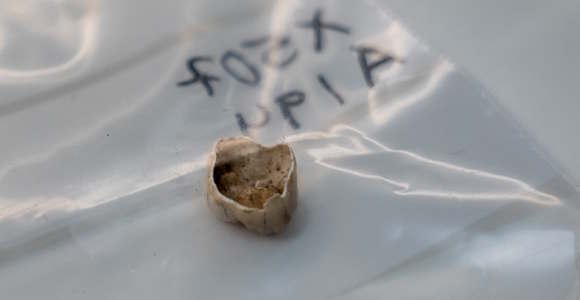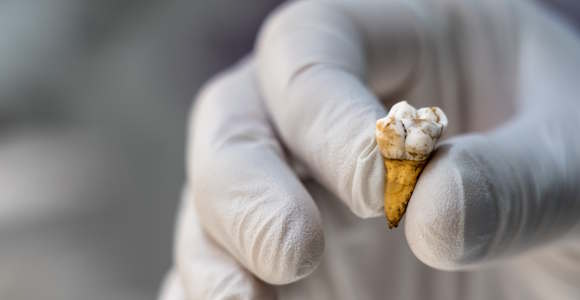
How Science Helped Archaeologists Determine the Sex of Medieval Children
Between the years 1150 and 1450, more than 100 children were buried in a churchyard near Silkeborg. Just a tiny fragment of their tooth enamel is enough to reveal their sex—and that’s exactly what researchers at SDU have now done.
At Museum Silkeborg, curator Kirsten Nellemann Nielsen knew she was working with a medieval cemetery: 448 individuals were laid to rest there between the years 1150 and 1450. Yet during the excavation at Virklund, near Silkeborg, only a few skeletons were recovered.
That in itself is not unusual. Unless the soil conditions are exceptionally favorable, most medieval skeletons have long since decayed. One thing, however, is far more durable than bones: tooth enamel. Though fragile, it can remain in the soil for centuries, in the form of tiny shells.
“Previously, enamel was often left in the soil after an excavation, because we couldn’t use it for anything. Today we know that enamel contains valuable information, and that’s what we’ve taken advantage of here,” explains Nielsen.

Enamel is made up of special proteins that indicate whether the tooth belonged to a male or a female. In adult skeletons, sex can usually be determined from the bones themselves.
But with children, this is not possible—here, enamel provides the answer.
After consulting with SDU’s Anthropological Department (ADBOU), Nielsen sent enamel fragments from 91 of the 123 children buried in Virklund to Professor Frank Kjeldsen, an expert in protein research at SDU’s Department of Biochemistry and Molecular Biology.
Why were there more dead girls?
Together with his colleague, lab manager Vladimir Gorshkov, he was able to determine the sex of 90 of the 91 samples. Only one fragment was too degraded to analyze. Of those 90 children, 41 were boys and 49 were girls.
“That’s a slight majority of girls, and that is a little surprising, because we know that statistically, more baby boys than baby girls die in infancy—a trend that still holds today. In that light, there should be more dead boys”, says Nielsen.
A question arises: Why were there more dead girls?
Maybe the villagers took better care of their sons
“The dataset is very small and not something we can draw firm conclusions from, but one could speculate that families in this village may have taken better care of their sons than their daughters. But again: this is a very small dataset, so this is only a possible explanation”, says Nielsen.
To her knowledge, this study represents one of the first and largest applications of proteomic sex determination on children’s skeletons from a medieval cemetery in Denmark, and she looks forward to further analyzing the data:
"For example, we are interested in investigating at what age the boys and girls died".

The population of the small Virklund village is estimated at only 40–50 people, with around two deaths per year. Almost none were buried in coffins, suggesting most in the village were poor. The average life expectancy was about 40 years—lowered significantly by high child mortality.
Among the adults buried, there is an equal gender distribution. In the Middle Ages, men were often buried on the south side of the church, and women on the north side—the south was considered more prestigious.
“But in Virklund, we see nearly equal numbers of men and women on both sides. We don’t know yet whether Virklund was unusual in this regard, or whether the general pattern was less strict than we’ve assumed,” Nielsen explains.
The special thing about tooth enamel
At SDU, Kjeldsen’s team developed a specialized method for sex determination by analyzing fragments of dental enamel.
Enamel, the outer layer of teeth, is acellular, which means it is not living tissue, and it forms only once during childhood. During that process, enamel is created by some proteins, first and foremost amelogenin.
“What is special for amelogenin, is that it is found on both the X and Y chromosomes, producing two slightly different protein variants with slightly different amino acid sequences. These small differences can be identified with mass spectrometry, allowing us to determine the bearer’s biological sex”, explains Frank Kjeldsen.
A technique that does not need much of the archeaologist’s material
In fact, amelogenin is ideal for mass spectrometry, he adds: It’s usually easier to analyze proteins when they’ve been broken into smaller fragments, and most researchers deliberately split them before analysis. But amelogenin naturally breaks into fragments during tooth maturation, which makes it especially straightforward to detect.
Another advantage: only a tiny amount of enamel is needed.
“We used just a very small portion of each fragment. After analysis, enough enamel remained to repeat the test 20 to 40 more times,” Kjeldsen notes.
Meet the researcher
Frank Kjeldsen is a professor and expert in protein research at Department of Biochemistry and Molecular Biology.